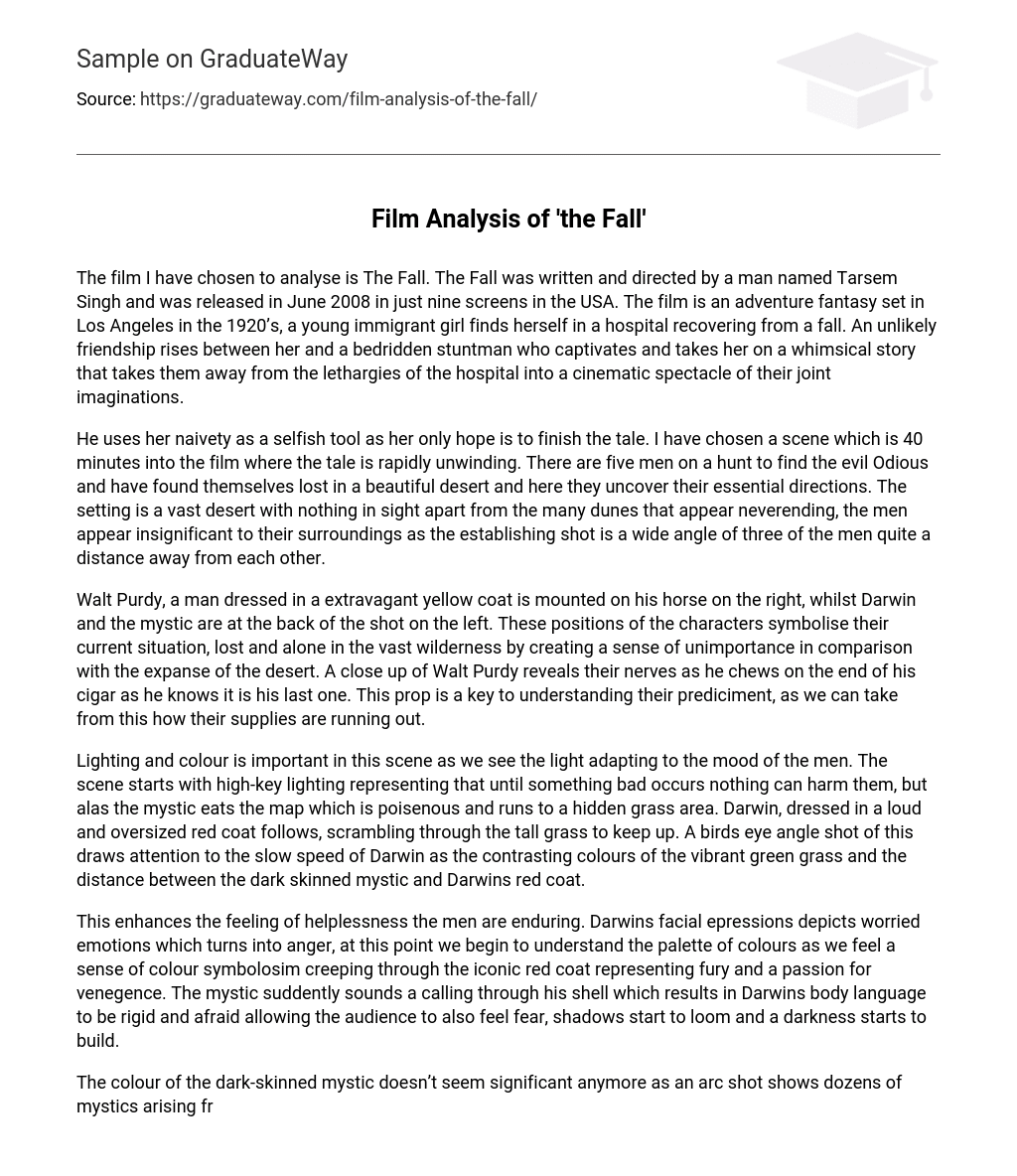The Fall, directed and written by Tarsem Singh, was released in June 2008 on just nine screens in the USA. It is an adventure fantasy film set in 1920’s Los Angeles. The story follows a young immigrant girl who ends up in a hospital after a fall. In the hospital, she forms an unexpected bond with a stuntman who is confined to his bed. Together, they embark on a whimsical journey that transports them from the dullness of the hospital into a cinematic spectacle created by their shared imaginations.
He manipulates her innocence for his own selfish gain, knowing that she has no other option but to complete the story. I have decided to analyze a specific scene that occurs 40 minutes into the movie, where the narrative is rapidly unraveling. In this scene, five men embark on a mission to find the villainous Odious but find themselves disoriented in a stunning desert. Here, they come across crucial directions that will guide them. The setting is an expansive desert, devoid of any visible features except for the seemingly endless sand dunes. In comparison to their surroundings, the men appear insignificant, highlighted by the wide-angle shot that shows three of them standing far apart from each other.
On the right, we see Walt Purdy, a man wearing a fancy yellow coat, sitting on his horse. On the left, we have Darwin and the mystic positioned at the back of the shot. These arrangements of the characters serve as a representation of their current situation – lost and isolated in the vast wilderness. It creates a feeling of insignificance when compared to the vastness of the desert. In a close-up shot, we can observe Walt Purdy’s anxiety as he nervously chews on his cigar, realizing that it is his last one. This particular prop holds significance in understanding their predicament as it indicates that their supplies are depleting.
The lighting and color in this scene are crucial as they reflect the men’s mood. Initially, the scene is bathed in high-key lighting, symbolizing their invincibility. However, things take a turn for the worse when the mystic consumes the poisonous map and flees to a concealed grassy area. Darwin, sporting a flamboyant oversized red coat, tries to keep up by scrambling through the tall grass. A bird’s-eye view shot highlights Darwin’s slow pace and emphasizes the contrasting hues of the vivid green grass against the dark-skinned mystic and Darwins red coat.
The men are experiencing a deep feeling of helplessness, which is further emphasized by Darwin’s facial expressions. Initially showing signs of worry, his emotions gradually transform into anger. This is the moment when we start to grasp the significance of the various colors, as they become symbols that convey a sense of revenge and fury. Suddenly, the mystic emits a sound that resonates from his shell. As a result, Darwin’s body language becomes tense and fearful, allowing the audience to also experience fear. Shadows begin to grow larger, creating a looming darkness.
The color of the dark-skinned mystic no longer holds importance, as a camera angle captures numerous mystics emerging from the mud and forming a protective circle around him. This moment is crucial in the scene, as the mud-covered mystics gather around their fallen comrade. A distant shot shows Darwin appearing perplexed, followed by a perspective shot from Darwin’s point of view. The lighting dramatically shifts to low-key illumination.
The camera pans back to the mystics, with shadows cutting across, in adherence to the 180° rule. The audience sees their dark figures huddled together, resembling West African dancers, as they begin to melodically chant and drum. This presents a new theme of spirituality to both the audience and the characters. Darwin’s stiff posture and the encircling shadows around the mystics symbolize how fear is a common response when encountering new people and situations.
Within the context of the hospital, stuntman Roy utilizes his own life as a storyline, sharing it with young Alexandria. The incorporation of mise en abyme emphasizes the absence of consistent narration in Roy’s fictional tale, as Alexandria remains oblivious to the metaphorical and personified aspects of the characters. Additionally, the portrayal of Walt nervously chewing on a cigar end serves as a metaphor for Roy’s unhealthy dependence on morphine and his lack of control over his current bedridden state.
The mud men’s forceful and enthusiastic dancing reveals that they are giving directions, according to Darwin’s realization. Their faces are covered in drying mud, creating a white crust, and as the sun shines on their dry faces, a shift in mood is depicted. This change is reflected in the vivid color contrast of the green and yellow sand dunes – the most revitalizing colors.





